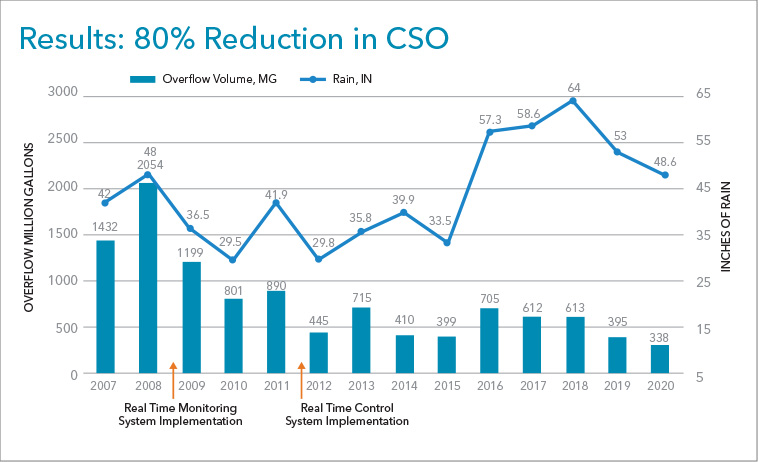Utility reduces CSO volume by 80%, saving $400 million in CapEx spending using “smart sewer” technology
City of South Bend, Indiana
United States
The St. Joseph River has long shaped South Bend’s economy, especially during the mid-20th century, when the river was the conduit to heavy industrial development such as Studebaker and the Singer Sewing Company. Despite the demise of heavy industry in the 1960s, the City is still the economic and cultural hub of Northern Indiana, and the St. Joseph River is still the central downtown attraction. Over the past decade, the City’s population has started to grow for the first time in 50 years, and the old Studebaker plant and surrounding area is being re-ignited as a technology center to attract new business.
To reduce the 1-2 billion gallons of polluted water dumped in the St. Joseph River annually, and the huge environmental, social, and economic costs associated with the ongoing issue, the City embraced a way to harness intelligent watershed technology to optimize its existing sewer system, without the need to build costly new gray infrastructure.
Challenge
Prior to 2008, virtually every time it rained heavily, the City of South Bend faced sewer overflows into the landmark St. Joseph River because the City`s aging sewer system could not handle the excess discharge, an average of some 1-2 billion gallons annually.
In 2012, the City entered into a consent decree, agreeing to a long-term control plan (LTCP) of their sewer overflow estimated at $713 million in capital improvements plus financing costs. For South Bend, with a population of just over 100,000, this equated to a significant burden per citizen, which is economically unfeasible given that the average annual household income is around $32,000.
Solution
South Bend turned to Xylem for help to solve the overflow problem. After a thorough data review in 2012 the system was expanded with Xylem Vue powered by GoAigua's SSO/CSO Predicition and Prevention applications, a real-time decision support system consisting of smart sensors and actuators. Xylem’s system enables the network to react to sudden wet weather events to avoid sewer overflows and prevent water pollution by trading available sewer capacity in real time and moving flows to under-utilized parts of the network.
SSO/CSO Prediction and Prevention serves overflow information via SCADA screens to operators, via smartphones and tablets to field staff, and through Web portals jointly developed with the City’s engineering staff. A key benefit is that operators have the ability to override the system at any time and take control.
“We spent 400 million dollars less than originally estimated, achieving the greater environmental benefit and level of service, just by optimizing the existing system in the ground.”
- Eric Horvath, Director of Public Works, City of South Bend
 Since 2012, the monitoring sites (currently 165) and 13 automated gates and valves have eliminated dry weather overflows and reduced combined sewer overflow (CSO) into the St. Joseph River by 80 percent.
Since 2012, the monitoring sites (currently 165) and 13 automated gates and valves have eliminated dry weather overflows and reduced combined sewer overflow (CSO) into the St. Joseph River by 80 percent.
Eric Horvath believes in the benefits of the real-time decision support system approach. In 2021, the Department of Justice and the US Environmental Protection Agency endorsed the City of South Bend’s updated long-term control plan requiring 60% less infrastructure investment than originally estimated, saving the City approximately $400 million in capital expenditure spending.
Outcome
Since implementing its smart sewer program, dry weather overflows have been eliminated and combined sewer overflow volumes have been reduced by more than 80 percent, or roughly one billion gallons per year. South Bend has also enjoyed approximately $1.5 million in annual operating and maintenance cost savings. In addition, E.coli concentrations in the St. Joseph River have dropped by more than 50 percent on average, improving the water quality.

Overall, this real-time decision support system allowed South Bend to reduce costly traditional gray infrastructure, while improving system performance and capacity utilization, lowering operating costs and delivering environmental gains 10 to 15 years ahead of schedule.
Let’s see what’s possible for water.
Learn more about Xylem Vue powered by GoAigua's SSO/CSO Prediction and Prevention

Learn more about Xylem Vue powered by GoAigua's smart, end-to-end wastewater system that helps utilities optimize network and operations at significantly lower costs.
Read Digital Twin eBook

When digital twins are coupled with advanced data science like hydroinformatics and water system expertise, utilities are empowered with the intelligence they need to make crucial decisions, earlier. Discover the steps water managers can take to adopt and maximize a digital twin, today.
Webinar: How the City of South Bend saved $400M and reduced CSOs by 80%

Hear how the City of South Bend optimized its existing sewer system, protecting community health and solving overflows without the need to build costly new gray infrastructure.
Take the next step to optimizing your wastewater networks
Start analyzing your wastewater networks to improve operational efficiency and reduce costs.
Learn more about Xylem Vue
Learn how Xylem Vue is redefining what's possible for water with digital solutions that empower utilities to deliver transformative outcomes to their communities.

